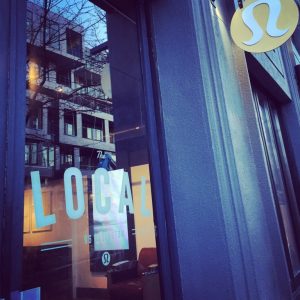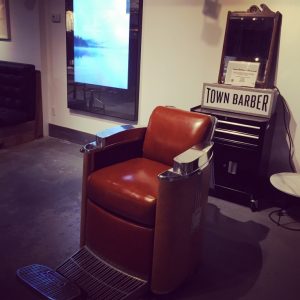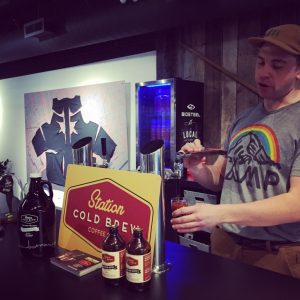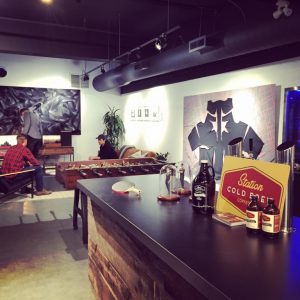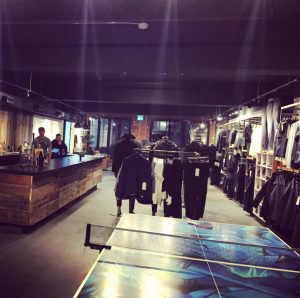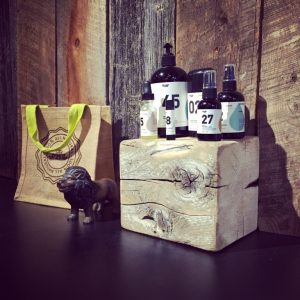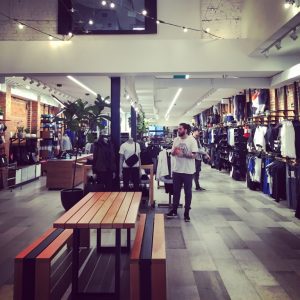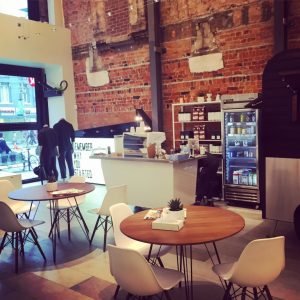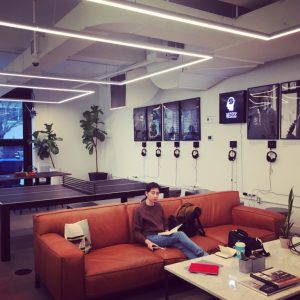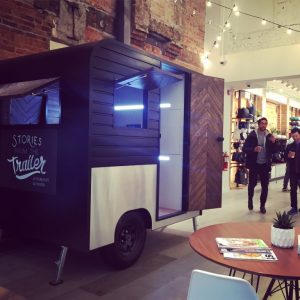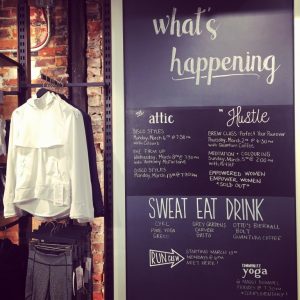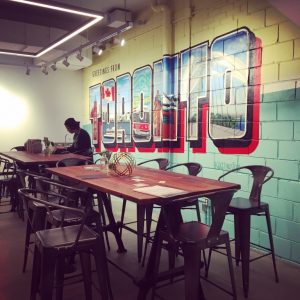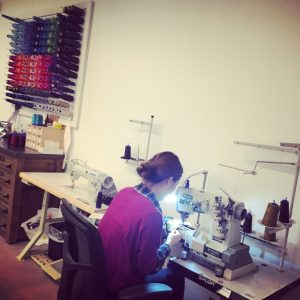In design, much of our work is based upon an understanding of an existing built environment. To be innovative, one must understand from where we came, where we are now, and where we are going.
This past semester in my retail design studio, Redefining the Retail Experience: Designing for a Sustainable Future, I asked my students to start the design process developing case studies. Like in practice, we began the design process with conceptual ideation and programming. In the programming phase, designers are charged with investigating precedents of similar typology. In the case of our studio, it became quite the challenge searching for brands that have innovative retail experiences and help redefine the purpose of the retail store – primarily through a unique customer journey that promotes environmental and social sustainability.
Introducing this assignment, I presented my own case studies of the Tom’s store in Austin, Texas, and the Lush store in London (see previous blogs). These stores redefined their programmatic elements to foster a community with shared values. In short, they went beyond just selling products and maximizing their square footage, and rather, provide services and community spaces. Another retailer set the precedent this past fall: Lululemon’s new concept stores “go local” to create a new dynamic, communicating brands values through crafting community.
Photography: Rebekah L. Matheny, Columbus, Ohio
The concept of localization isn’t new or radical. Starbucks transitioned years ago from the rollout of the “every store looks the same across America” concept to a more localized strategy. We know that customers are looking for unique shopping experiences, possibly even those that enrich their lives and are more meaningful. Over the last year, Lululemon took the idea of localization to a new level, opening two new stores in Toronto and around the world, from Bend, Ore., to Bondi Beach, Australia.
Lululemon’s men’s concept, “The Local,” opened its doors in December 2016, becoming Canada’s newest men’s store, following in the footsteps of “The Joinery” in New York. Though the footprint of the store is smaller than most, the energy within the space gives off chill vibes. The radical brand change takes shape through the store’s organization and purpose; only half of the space is dedicated to their products. Rather, the true focus is the community space and activities that demonstrate the brand’s investment in the local community by giving men a place to connect, collaborate and create.
Advertisement
Photography: Rebekah L. Matheny, Columbus, Ohio
A barber chair sits to the right of the main entry, in view of the front window. One might suspect that the chair is just for aesthetics, but when inquiring, Alex, the store’s “community coordinator,” explained that Town Barber comes in every Saturday for beard trimmings, and customers can give a minimum donation of $10 for services, which is then donated to a local charity. This small gesture brings the brand’s commitment to improving the local community to the forefront of the retail experience.
Just past the barber chair, there’s a long community table adorned with chess and backgammon where patrons are welcome to sit, drink coffee and peruse the web. Halfway through the store, a typical cashwrap doubles as a bar, serving up free cold brew on tap, as well as craft beer collaborations with local breweries during their “happiness hour” events. People seem to just stop in and hang out. During the time I was there, a group of guys were hanging out in the back drinking coffee, talking and playing foosball. Later, a couple strolled in, grabbed Ping-Pong paddles, then plugged in their phones to change the music from the coffee shop vibes of Bon Iver to the more energized sounds of Drake, which was (ironically) apropos.
Photography: Rebekah L. Matheny, Columbus, Ohio
Local artisans and makers once again created a space that’s less about their products and more about the community, and craft all of the featured artwork and activity tables. If you are here to pick up a new pair of running shorts, the store manager (who’s known as “the curator”) will happily check you out at the bar and remind you of the product’s care instructions. As the community coordinator explained, the store needs no advertisement; purely by word-of-mouth people come to collaborate in the space, to be part of a community supported by a company that shares their values.
When I asked my students to redefine the customer journey and to go beyond thinking of selling product, and instead focusing on fostering a community, these are exactly the type of innovative ideas I had in mind.
Advertisement
Photography: Rebekah L. Matheny, Columbus, Ohio
Down Toronto’s Queen Street, Lululemon’s three-floor, 10,000-square-foot store is said to be the first of its kind in Canada. The flagship is part retail space, part local pop-up shop/art gallery, part living room and part practice studio. The company’s values of community and product longevity come to life in the experience: The customer is greeted not by product, but by the rotating pop-up shop within “The Residency” which has transformed from a cold brew station to a juicery to a café since it’s opening in early fall. The art within the space also rotates to feature new emerging artists, taking the brand’s approach to connecting local people through their “ambassadors” to a new level.
As the billboard within “The Residency” tells customers, “Every family has a story … Welcome to ours.” This message is spot on, from the retro trailer that encourages customers to share their story to the “The Hustle” living room space to “The Attic” on the third floor, which has a packed schedule of yoga, meditation and even boxing classes. The entire customer journey is an unfolding of the brand’s story and values.
Photography: Rebekah L. Matheny, Columbus, Ohio
A main attraction on the first floor is the community space. “The Hustle,” a multifunctional living room space, anchors the journey, allowing customers to pop in for the free Wi-Fi but stick around for the workshops. Everything from raw food cooking classes to athletic discussions with brand ambassadors to the sold out “Empowered Women Empower Women” presentations cultivates a community of activists which, in turn, breeds brand ambassadors. Carving out this community space further emphasizes the brand’s dedication to educating, inspiring and challenging their communities to become leaders in sustainability.
This space also features a hem and repair station where a seamstress is elevated to a valued aspect within the brand’s product lifecycle. In a typical store, if the sales associate doesn’t mention it, customers might not realize that Lululemon’s products can be repaired by the brand. Customers also might not know the company recycles 98 percent of its damaged products into stuffing for mattresses and insulation for homes and cars, as well as sporting equipment like boxing gloves and punching bags. By having this work zone not located in “The Loft” with the other office spaces, or even off-site like in most stores, customers can interact with the person doing the repairs. (They also serve as educators teaching customers about the company’s sustainable initiatives and explaining how to reduce product waste through the the repair process.)
Advertisement
Photography: Rebekah L. Matheny, Columbus, Ohio
When thinking about redefining the “future of retail” and designing a more sustainable future, both environmentally and economically, these programming and service initiatives are steps in the right direction. In the words of Lululemon, “Come join the hustle,” the creative hustle, and redefine a sustainable retail future!
According to Lululemon, the focus of the store will be sweat, personal development, and relationships. That third point shouldn’t come as a surprise since Lululemon trains its sales staff to develop relationships with its customers, which works can lead to lasting friendships — and moreover, brand loyalty. This friendship-building atmosphere has led to a strong following for Lululemon, which has helped drive sales over the years:
Rebekah L. Matheny is the assistant professor of interior design at The Ohio State University (Columbus, Ohio), where she teaches courses in interior finish materials, lighting design and design studios that integrate a retail brand strategy process. Matheny’s research investigates the sensory perception of interior finish materials and their application in retail design to create an emotional connection between the customer and the brand. Follow Rebekah and her journey with materials on Instagram @rebekahmathenydesign and to start a dialogue about the sensory experience of materials visit her web site interiormaterialsmatter.com.


 Photo Gallery2 days ago
Photo Gallery2 days ago
 Headlines1 week ago
Headlines1 week ago
 Headlines2 weeks ago
Headlines2 weeks ago
 Sector Spotlight2 weeks ago
Sector Spotlight2 weeks ago
 Headlines1 week ago
Headlines1 week ago
 Headlines4 days ago
Headlines4 days ago
 Headlines2 weeks ago
Headlines2 weeks ago
 Designer Dozen1 week ago
Designer Dozen1 week ago

